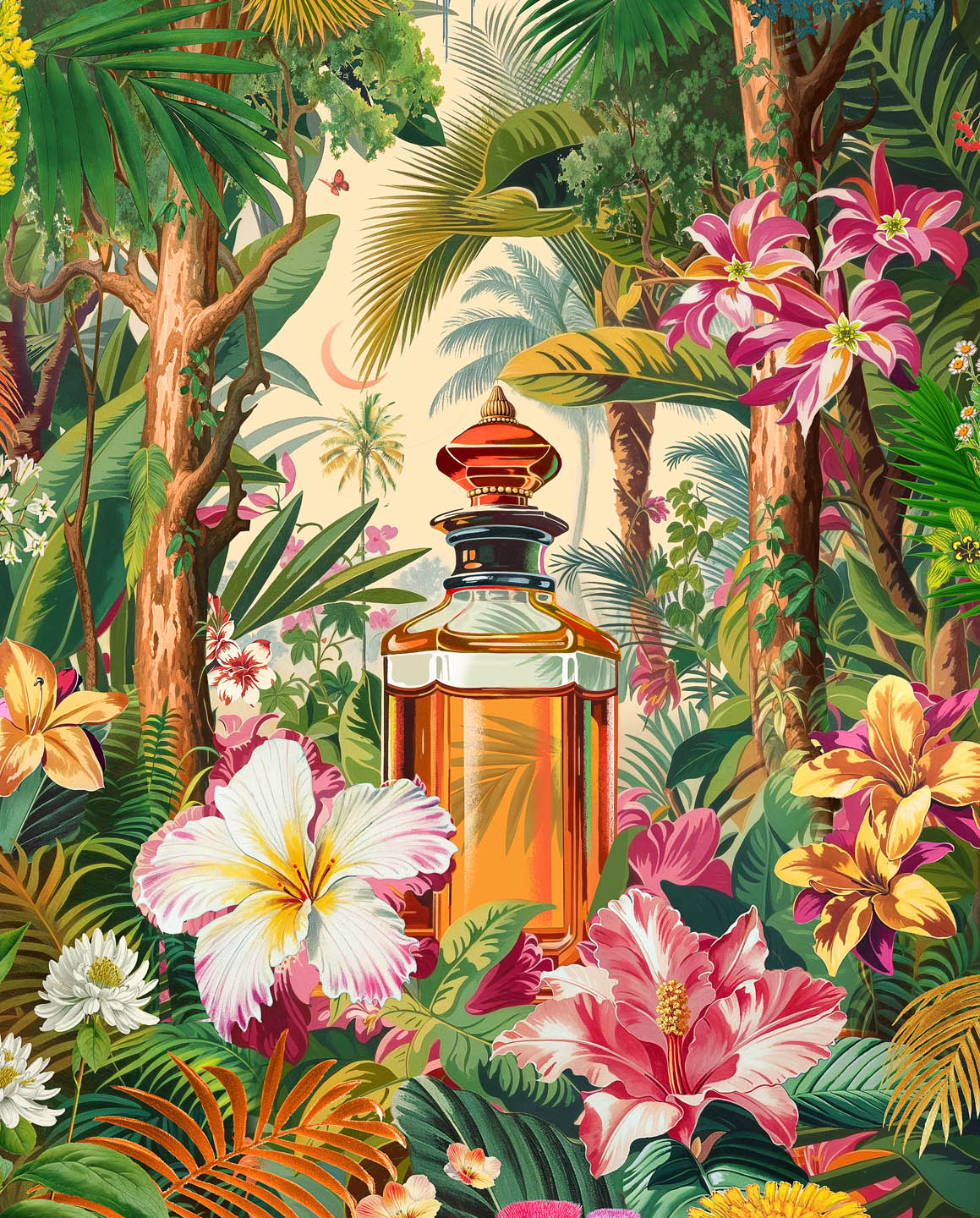Vancouver is now only a direct flight away from Dubai on a new seasonal route from Air Canada, restarting October 28. Read more Dubai travel stories.
The narrow alleyways of Souq Al Tawabil, Dubai’s spice market, crowd the senses. Glittering gold and pearls drip from displays of extravagant wedding jewellery. Gentle clouds of sandalwood smoke waft from the doorways, past brilliant cones of turmeric, saffron, cumin, and pepper. Camel-milk ice cream is sweet and acidic on the tongue, and distant music—Arabic, Bollywood, American pop—twangs over the rooftops. Down one side street, every shop window is lined with tiny bottles, ornately wrapped, with the smells of rose, orange blossom, and musk fighting for space in the air. Throughout the clamouring market, one sensation is almost constant: a persistent olfactory bass note that thrums in the nostrils with the unmistakable scent of Dubai.
This is oudh—the unrivalled favourite perfume of the Emirates. Woody, musky, deep, complex, soothing, and smoky, the smell of oudh cannot be adequately expressed through words and, like all great scents of perfumery—ambergris, tuberose, jasmine—must be breathed in to be experienced. With the finest expressions more expensive than pure gold by weight, the precious oil is a link to the distant roots of Arabian culture, even in the hypermodern bustle of downtown Dubai.
The story of oudh begins in the jungles of Cambodia, India, or Indonesia when an agarwood, a tree of the genus Aquilaria, comes under attack. A frequent invader is Dinoplatypus chevrolati, the ambrosia beetle, a ruddy cigar-shaped insect with a unique feeding strategy. The beetle bores its way through the protective bark, making its way to the exposed heartwood where it performs a remarkable trick of biological magic. It carries with it a symbiotic fungus that attacks the wood of the tree, sapping nutrients that are consumed by the beetle and its offspring. But the agarwood is not defenceless. To fight off the infection, the tree produces a thick resin that repels the fungus, and its heartwood turns from pale and colourless to dark, sticky, and fragrant. Only from this infected heartwood can oudh be extracted, as wood chips, resinous chunks, or pure oil. In a forest of agarwood trees, only a handful are likely to contain oudh, and more than 100 kilograms of wood are required to distill a litre of oil. While oudh is often faked or adulterated due to its rarity, the incomparable aroma of the pure substance is prized by perfumers, especially on the Arabian peninsula.
“Oudh is very, very important in this part of the world,” says Forat Al Haider, the Iraqi-born and Swedish-raised director of beauty innovation at Dubai luxury perfume brand Ghawali. “It’s incense, it scents your clothes, your home, and is used to create your own personal scent, which is something that’s been part of this culture for centuries.”
In an environment where the hot sun traditionally necessitated that both men and women cover themselves in loose clothing, he explains, perfume is used to create a recognizable personal identity. Emiratis layer scents in a unique individual blend, with varieties of oudh—bold Indian, woody Indonesian, or sweet Cambodian—lending a structuring deep note. On long rides through the desert, in years past, a Bedouin man would store a dab of his wife’s distinct perfume in the tassel of his headdress as a keepsake.
Though agarwood itself is not native to the harsh deserts of Arabia, the scent has worked its way deep into Arab culture, borne on the spice routes that have linked East and West for centuries. The first mentions of the wood appear in Hindu vedas over 3,000 years ago. Oudh perfumes the robes of a king preparing for marriage in a psalm of the Hebrew bible, and in the Hadiths the prophet Muhammad describes oudh smouldering in the incense burners of paradise. At the death of Harun al-Rashid, renowned caliph of Baghdad and a central character in the fictionalized Arabian Nights, 1,000 baskets of oudh wood were recorded in his personal treasury.
In international Dubai, oudh’s long history collides with a culture that is unmistakably modern. Today, instead of in a crowded market, a visitor is as likely to encounter oudh sampled through a copper cone at Ghawali’s Dubai Mall retail shop, in the shadow of the cloud-piercing Burj Khalifa. In nearby western shops, you’ll find oudh blended into luxury perfumes, from Tom Ford’s Oud Wood to Dior’s Oud Ispahan to Maison Francis Kurkdjian’s Oud Satin Mood. But as western luxury brands have incorporated the scent into their fragrances, Arab perfumers like Ghawali are trying to broaden the audience for oriental perfumes and develop hybrid formulas that blend tradition and modernity.
“People have the notion that oriental perfumes are only for oriental people. I think that’s one of the misconceptions that you find,” Al Haider says. “There’s a stereotype I’ve had to beat quite a few times that oriental perfumes are super strong or suffocating, and that’s why I’ve focused on creating very floral scents.”
He’s most proud of his collaboration with Maitha Al Maktoum, daughter of Dubai’s ruler, and a sheikha of the Maktoum clan that has ruled Dubai for nearly two centuries. This perfume, called Nomadic Dreams, borrows elements of both Arab tradition and the sophistication of contemporary perfumery, with notes of oudh, bergamot, orange, ginger, and cacao wood—a nod to Dubai’s traditional past and forward-looking optimism.
“We want to change this idea that oriental perfumes are just about oudh,” Al Haider says. “You’ll see in Dubai that not everything is black and gold, you know. We have sand, palm trees, water, stone. And so we’re really focusing on putting a contemporary touch on something that is part of our heritage and tradition.”
Read more from our Spring 2024 issue.









